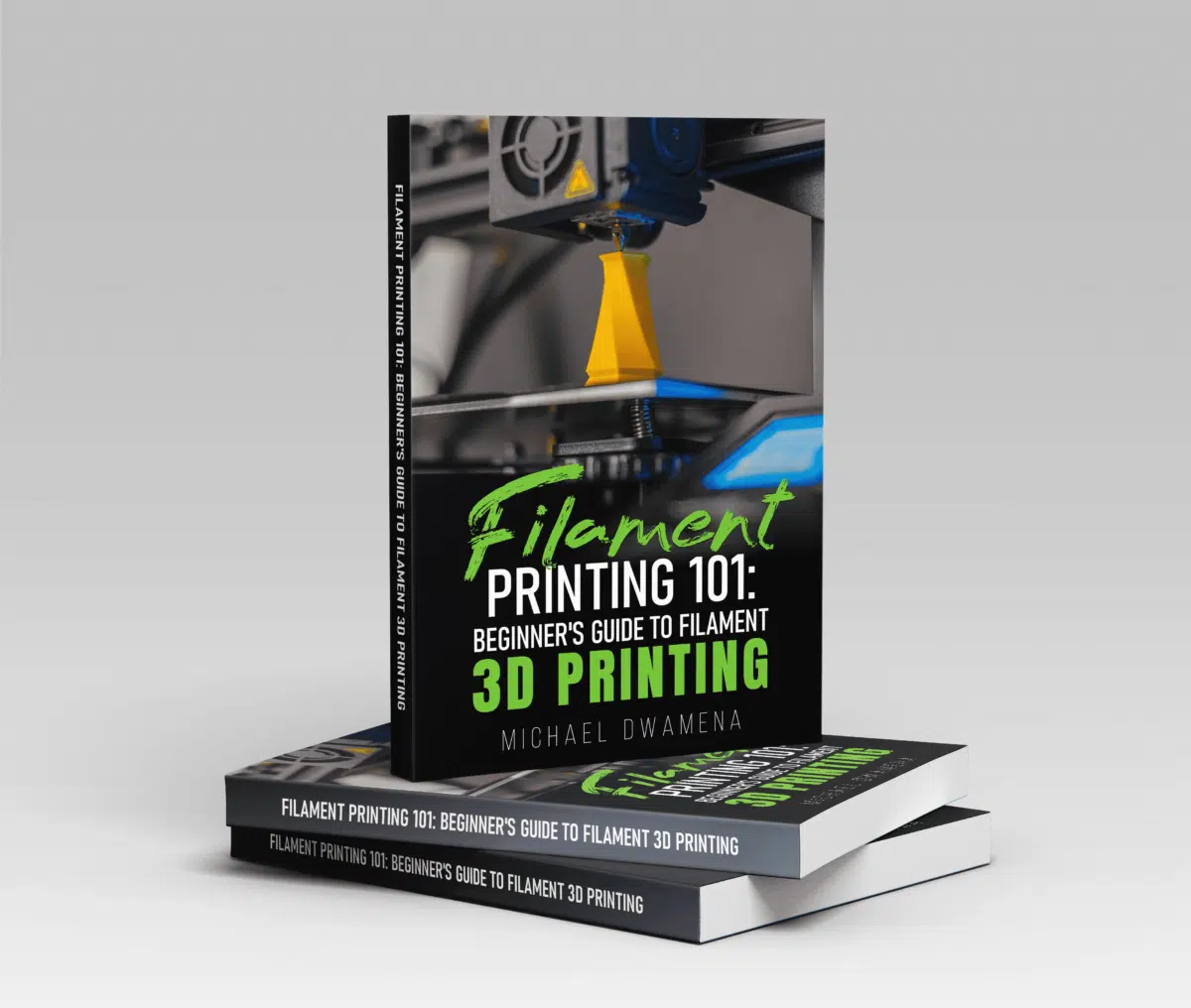When switching from FDM to resin 3D printing, you have to get used to a whole new set of calibrations and adjustments.
A common query regards the resin melting point – which you might wrongfully believe affects the printing process.
The truth is that resin doesn’t have a melting point. All 3D printing resins come in liquid form and are fundamentally different from FDM filaments. They are not thermoplastics and cannot melt, but they do have a heat deflection temperature – that you should know to determine whether the resin you want to use fits the application.
How Melting Point Affects Resin 3D Printing
Thermoplastic filaments used in FDM printing have melting points that play a crucial role in extrusion. The melting point of each material determines the bed and hot end temperature. However, this is not true for 3D printing resins.
Resins are not thermoplastics but liquid thermoset chemicals that are used at room temperature. They are poured into a resin tank from where a VAT platform extracts them. Each resin layer is then cured under UV light.
Light plays a crucial role in the resin 3D printing process, hardening the liquid substance.
What determines the print quality is the exposure time, which should be optimized for each resin type. The lamp quality and, eventually, the type of printer you’re using also play a role.
While the melting point is not important when printing with resin (there is none, since resin is already liquid), you should care about the material’s heat deflection temperature.
Heat deflection temperature only affects resin after it has been cured. Essentially, this is the point at which plastic objects begin to deform.
- Our new Filament Printing 101 Course is just for you! Lean how to create perfect professional prints without all the hassle.
- Don't let common mistakes hold you back, click the link to learn more and get ahead now!
Each resin type has a different heat deflection temperature, and knowing it is crucial to determine the resin’s suitability for a specific application.
For instance, you might want to use resin with a high heat deflection temperature for objects that will be exposed to sunlight or used outdoors.
Industrial parts that have to resist heat exposure should also be printed out of materials with a high heat deflection temperature.
Types Of Resins And Their Melting Points
As explained, 3D printing resin doesn’t have a melting point. If you’re wondering what temperatures your printed objects can withstand, the correct term is heat deflection temperature.
The table below shows the heat deflection temperatures of various 3D printing resins. For the best results, store and use them at a temperature of 25°C:
| Resin Type | Heat Deflection Temperature |
|---|---|
| Photopolymer Resin | 460°F to 552°F |
| Epoxy Resin | 100°F to 130°F |
| Nylon Resin* | 140°F to 320°F |
| PETG Resin* | 160°F to 217°F |
*Nylon and PETG resin refer to resins with nylon-like and PETG-like properties. Nylon and PETG are thermoplastics (FDM filaments), and they do not come in liquid resin form.
Photopolymer Resin
Photopolymer is a term designating light-sensitive materials, and this umbrella term includes a variety of resins commonly used in SLA, DLP, and LCD 3D printing.
They vary from flexible, rubber-like resins to ultra-rigid resins, including PLA-like, ABS-like, and PETG-like variants.
All these resins are thermoset, which basically means that they need light to cure and develop specific mechanical properties.
When cured, they look like filament prints. However, the resolution is usually much higher so the prints are easier to post-process and have a greater level of detail.
Photopolymer resins have a wide range of heat deflection temperatures, depending on their type and actual composition.
Usually, the printed objects remain stable and maintain their shape at temperatures lower than 460°C. Some resins have even higher heat deflection temperatures, up to 552°F.
Photopolymer resins can be used for a variety of hobby and industrial applications, including jewelry making, dental prints, engineering, research prototypes, etc.
Epoxy Resin
Three dimensional printing epoxy resin is known for its resistance and chemical stability.
It usually comes in a liquid mixed – unlike conventional epoxy resin that requires you to add a hardener to the mix. This makes it possible to cure it with light; hence, it is suitable to use with SLA 3D printers.
Despite its physical properties once cured, epoxy resin is a lot less common than photopolymer resins. Its low popularity is given by the harmful chemical formula.
These resins are typically cytotoxic, meaning that even a brief contact with the liquid can increase health hazards.
Another disadvantage of this resin type is its poor resistance to temperature once cured. Its heat deflection temperature is the lowest, typically between 100 and 130°F.
However, while this resin has poor resistance to impact and temperature, it could be a good choice for printing miniatures or artworks.
Nylon Resin
Nylon-like resin is a photopolymer too, but it needs a category of its own due to the low heat deflection temperature compared to the majority of other photopolymer resins.
This compound is usually used for LCD and DLP prints that require a high resolution, including works of art, miniatures, and jewelry. Its good fluidity also speeds up printing.
Yet, you shouldn’t opt for a thick layer if you want to keep the resolution as high as possible.
Nylon-like resin has a heat deflection temperature between 140°F and 320°F. While it is not the first choice for engineering and biomechanical applications, it is often used for dental prints and other medical applications.
PETG Resin
While PETG-like resins are not really a thing, there are resins with similar properties once cured. They usually have the same heat deflection temperature as PETG, which is around 160°F to 217°F.
Parts printed with PETG-like resin can usually undergo a lot of physical stress and are less brittle than epoxy. They also have good flexural strength, making the material good for jewelry printing and hobby applications.
Factors That Affect Resin Melting Point
We can’t emphasize it enough – 3D printing resins don’t have a melting point.
However, there are factors that affect the way they cure, as well as their physical properties once cured.
Molecular Weight
The main factor that determines the heat deflection temperature of a resin is its molecular weight.
However, you should consider the molecular weight once the part has been cured and post-processed, since the heat deflection temperature only affects the printed part.
Generally, the higher the molecular weight, the higher the heat deflection temperature. When exposed to temperatures way above the heat deflection temperature for a specific material, the cured resin will eventually melt again.
Cross Linking
Cross linking refers to a material’s ability to cure into a solid form. However, the way cross-linking happens – especially the time of exposure under UV light – can affect the heat deflection temperature.
Extensive cross-linking, which happens in substances with a higher rigidity or hardness, leads to a higher heat deflection temperature. Hence, flexible resins are usually affected by high temperatures more frequently than ultra-rigid resins.
Exposure Time
The exposure time is another factor that affects the heat deflection temperature, but this actually refers to the exposure time to heat, not to UV light.
It is easy to understand that the more an object stays under a heat source, the higher its chances are to reach the heat deflection temperature faster.
This is true regardless of the actual intensity of heat. Like staying under the sun heats you up gradually, the same happens to resin objects.
Rate of Temperature Increase
While the heat deflection temperature is not actually changed by the rate of temperature increase, this rate can have an impact on how the part actually handles heat.
When a cold part is suddenly exposed to a temperature above its heat deflection temperature, the object has a higher probability of deforming. This happens due to thermal shock, with effects ranging from a slight deformation to cracking or shattering.
However, if the temperature is increased slowly and gradually, the part can maintain its shape for a longer time. Sometimes, it can even maintain its shape for a while after the material reaches its heat deflection temperature.
Part Geometry
Ultimately, the geometry of the part also plays a role.
A part with all sides exposed to heat can reach its heat deflection temperature a lot faster than a part where only one side is exposed to heat. That’s because some of the heat is generally distributed to other sides of the part.
FAQs
What happens if resin is burned?
Since resin is not heated during the printing process, it can’t be burned by the printer. Instead, the burn-in process in resin 3D printing refers to a longer curing time for the first few layers of the print.
This process increases adherence to the build surface, and is the equivalent of using a slightly higher temperature for the hot end or build plate in FDM printing.
Depending on the color, the burn-in time can vary from about five to 12 times longer. Thus, if you normally cure a layer for three seconds, the burn-in will require between 15 and 36 seconds of curing for the initial layers.
If you’re wondering what happens if you heat an already cured resin part past its heat deflection temperature, the resin will scorch and deteriorate – it might look like melting, even if it’s not.
Since resin can’t go back to its liquid form once cured, the part is ruined forever.
Burning cured resin can also generate toxic fumes that can be harmful when inhaled. Generally, you can expect the same effects as with burning plastics.
Will resin crack in the heat?
Some resins will crack in the heat, especially when exposed to a sudden temperature change. For the most part, though, resin objects simply lose their shape when heated past their heat deflection temperature.
Exposing resin objects to low and high temperatures constantly can affect the physical properties of the cured resin, leading to cracking.
Next Steps
Three dimensional printing resin doesn’t have a melting point. This printing material – regardless of its type – is liquid. Resin 3D printers don’t use any kind of heat either. Instead, they use UV light to cure the material and harden it.
The burn-in process in resin printing refers to longer exposure to UV light of the first layers, enhancing adhesion to the build surface. This is particularly important, since resin printers usually build the objects upside-down.
Once cured, resins can be affected and deformed when heated past their heat deflection temperature. When this temperature is exceeded by lots of degrees, the material will scorch and deteriorate. However, once cured, resin can’t melt and return back to a liquid state.



